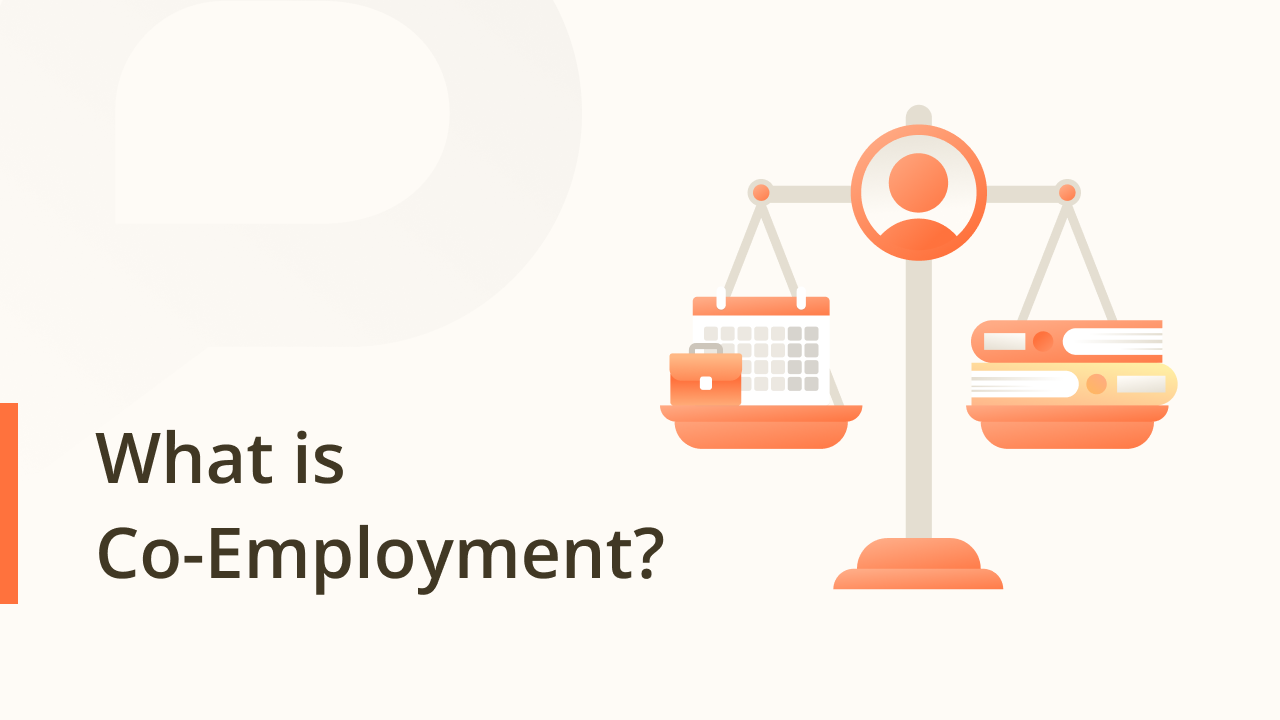Spending too much on recruitment, payroll or global HR?
We help you find the Best Providers at the lowest cost.
Co-employment arises when two legal entities share the employer’s responsibilities for one employee. Common in arrangements with professional employer organizations (PEOs), this model enables businesses to outsource specific HR tasks such as payroll, benefits administration, and compliance with employment laws. It effectively divides employer obligations between the client company, which maintains control over day-to-day operations and employee management, and the PEO, which manages administrative HR functions and provides expertise in complying with complex regulatory requirements.
Key Takeaways
- Co-employment allows businesses to share employee responsibilities with PEOs.
- It helps companies efficiently manage HR tasks and ensures compliance with laws.
- Organizations can mitigate risks and gain access to better employee benefits.
What is Co-Employment
Co-employment arises when duties are split between two entities, often the original employer and a Professional Employer Organization (PEO). This relationship enables businesses to outsource various human resources functions such as payroll, benefits administration, and compliance with employment laws.
In this arrangement, the client company controls their workers’ day-to-day activities, including the power to hire and fire. The PEO, conversely, becomes the administrative employer and manages tasks including:
- Payroll processing and tax filings
- Employee benefits administration
- Compliance with state and federal regulations
The classification of workers remains paramount to avoid complications. A critical aspect shared by the entities is the correct classification of employees to ensure compliance with labor laws.
Moreover, it’s important to note the difference between co-employment and joint employment. In joint employment, two businesses simultaneously exert a certain degree of control over the employee, which can happen naturally in staffing agency scenarios. Contrastingly, in co-employment, both parties agree to share specific employer responsibilities based on a contractual agreement.
Professional Employer Organizations become particularly valuable when they can leverage their scale to offer better benefits or more efficient handling of administrative tasks. However, it should be approached with clear understanding and consideration to reduce potential employer responsibilities and risks inherent in such relationships.
Role of Professional Employer Organizations (PEOs)
Professional Employer Organizations (PEOs) play a distinct role in the business ecosystem by handling critical HR functions and compliance responsibilities, which allows companies to focus on their core operations. They offer expertise in payroll administration, benefits management, and workers’ compensation.
Defining PEOs and Their Services
A PEO provides comprehensive HR support services by entering a co-employment agreement with a client company. In this arrangement, while the client company continues to manage the daily operations and direction of the workforce, the PEO handles HR tasks such as payroll administration and benefits administration, including health insurance and retirement plans and workers’ compensation programs.
PEO Relationship Dynamics
The PEO relationship is a partnership that leverages the strengths of the PEO and the client company. It is formalized through a client service agreement, which details each party’s responsibilities in this unique model of shared employment.
Compliance and Risk Management
PEOs come equipped with compliance expertise, especially in regulatory compliance and employer risks associated with HR. They are well-versed in local and federal regulations, mitigating potential business liabilities through meticulous risk management practices.
Benefits of Partnering with a PEO
Businesses that partner with PEOs can often access big-business benefits, such as comprehensive benefits packages, at a fraction of the cost. This includes not only health insurance but also peripheral benefits like commuter benefits. Companies can focus on scaling their operations and strategic initiatives by outsourcing these aspects.
Certification and Standards for PEOs
PEOs can obtain certification to ensure they meet high financial reporting and performance standards. Becoming a Certified Professional Employer Organization (CPEO) involves a stringent IRS certification process, which includes being audited and adhering to strict tax payment and reporting practices. This certification signifies trust and reliability in the PEO’s operations.
Employment Law and Regulations
In the realm of co-employment, compliance with employment law and regulations is crucial. Businesses must understand and adhere to the legal framework that governs employee relationships to avoid liabilities and penalties.
Navigating Employer Responsibilities
Co-employment arrangements come with shared employer responsibilities, requiring a clear understanding of what each party is accountable for. It’s essential to define these roles, often found within a contractual agreement, to maintain compliance with employment laws. Two entities might share control over workers, but each must follow their designated responsibilities, such as upholding workers’ compensation insurance requirements and adhering to workplace policies.
Classification of Workers
Accurately classifying workers is essential to comply with employment regulations. Incorrect classification can lead to issues such as misclassification penalties. In a co-employment scenario, this typically involves distinguishing between independent professionals who aren’t employees and thus not subject to the same taxes and benefits as regular employees. Staffing agencies and companies that engage in employee leasing must diligently classify staff to avoid legal complications.
Understanding Employment Taxes
Finally, co-employment often involves a shared responsibility for handling employment taxes. Both co-employers must understand their obligations related to payroll taxes, including withholdings for Social Security and Medicare. Ensuring proper handling of these taxes is a critical aspect of co-employment, as any errors can lead to severe financial and legal consequences.
Compensation and Benefits Management
In co-employment, adequate compensation and benefits management is critical to maintaining a productive workforce and ensuring compliance with various regulations. A Professional Employer Organization (PEO) partners with companies to streamline these processes, handling intricate details from crafting compensation structures to administering employee benefits.
Crafting Compensation Structures
Developing a compensation structure is a core function of co-employment. It involves determining salary ranges and increments that align with the company’s financial capabilities and strategic goals. Co-employment arrangements commonly lead to simplified payroll processing by leveraging the PEO’s established systems to ensure accurate and timely compensation. They use data and best practices to recommend competitive wage models that aid in attracting and retaining talent.
Administering Employee Benefits
When it comes to benefits administration, co-employment can bring significant advantages. A PEO typically offers a spectrum of employee benefits, including access to comprehensive healthcare and health insurance plans. These offerings can often surpass what a small or mid-sized company could provide. The PEO’s role includes benefits administration, handling the complexities of enrollment, management, and compliance, thus ensuring that employees receive their entitled benefits efficiently.
Operational Excellence in HR
Achieving operational excellence in Human Resources (HR) is vital for businesses looking to streamline processes and enhance the efficacy of their workforce. This effort focuses on tightening payroll and HR tasks, optimizing performance management systems, deploying technology solutions effectively, and fostering strong employee relations.
Efficient Payroll and HR Tasks
Businesses often seek to improve productivity by making HR tasks such as payroll administration more effective. By designing straightforward procedures and implementing best practices, they can ensure timely and accurate salary disbursement to worksite employees. A key component is staying compliant with tax laws and regulations, thus avoiding legal repercussions and employee dissatisfaction.
Performance and Workforce Management
A robust approach to performance management involves transparent communication about job descriptions, expectations, and feedback mechanisms, which can significantly affect employee satisfaction levels. Effective workforce management is crucial for aligning staff activities with company goals, optimizing resource allocation based on skills and performance data, and driving toward educational and learning opportunities for staff development.
Technology and HR Solutions
The strategic use of technology in HR can revolutionize how businesses manage their personnel. Companies can mitigate misconceptions about HR’s operational capabilities by employing automated HR tracking systems and software solutions. These technologies not only augment HR support but also provide reliable data that can be used to make informed business decisions.
Strengthening Employee Relations
Lastly, cultivating strong employee relations is instrumental in propelling a company toward operational excellence. Fostering a culture of recognition, supporting career advancement, and reinforcing the importance of education and continuous learning create a supportive work environment where employees feel valued and invested in their roles.
Risk Management and Workers’ Compensation
Risk management and workers’ compensation are critical components in co-employment arrangements as they cover the spectrum from meeting regulatory requirements to protecting against potential liabilities. Co-employers typically collaborate to navigate regulatory compliance and share responsibilities for maintaining workplace safety.
Handling Workers’ Compensation
Co-employment can simplify procuring workers’ compensation insurance, which is essential to cover medical costs and lost wages if employees get injured. The co-employer, often a Professional Employer Organization (PEO), typically provides this insurance, thus offering stability and reducing the administrative burden on the client company. An effective co-employment agreement ensures that employees receive prompt and adequate compensation benefits in case of a workplace injury.
Mitigating Potential Risks
The company and the co-employer must adhere to stringent workplace safety regulations to mitigate potential risks. By sharing liability, they collectively reduce the chances of accidents and injuries. The PEO’s expertise in risk assessment and safety program implementation can crucially support a business’s efforts to create a safer working environment, often resulting in lower overall workers’ compensation insurance premiums.
Expertise in Compliance Support
A co-employer provides valuable compliance support with up-to-date compliance expertise to ensure that the business adheres to all relevant regulations. Their proficiencies include navigating the complexities of state and federal regulatory compliance for workers’ compensation. This reduces the client company’s legal risks associated with non-compliance and allows business owners to focus more on operational aspects rather than regulatory concerns.
Resource and Contact Information
For individuals or businesses seeking to understand co-employment, many resources and professional contacts are available to clarify the concept and its implications. This section provides essential information and avenues to further education on co-employment and ways to connect with HR professionals.
Educational Resources and Learning
Client Service Agreement Explained:
Clients can often find detailed information about co-employment within the Client Service Agreement (CSA) that outlines the shared responsibilities between the client and the PEO. For an in-depth understanding, one can refer to the CSA or similar documentation provided by the PEO for specific delineations of roles and liabilities.
- Learning Materials:
Webinars and Presentations: Stay informed by accessing webinars and online presentations on co-employment, often available on PEO websites.
Articles and Research: For further reading, reputable sites like Forbes and SHRM offer articles that delve into the nuances of co-employment.
Connecting with HR Professionals
Contact Us Options:
Professionals interested in co-employment can contact HR professionals through various Contact Us options on HR and PEO industry websites. For personalized guidance:
- Direct Inquiries: Use the contact forms or email addresses to ask about co-employment arrangements.
- Networking Events: Attend local or online networking events to connect with HR professionals with co-employment and other employment arrangements expertise.


